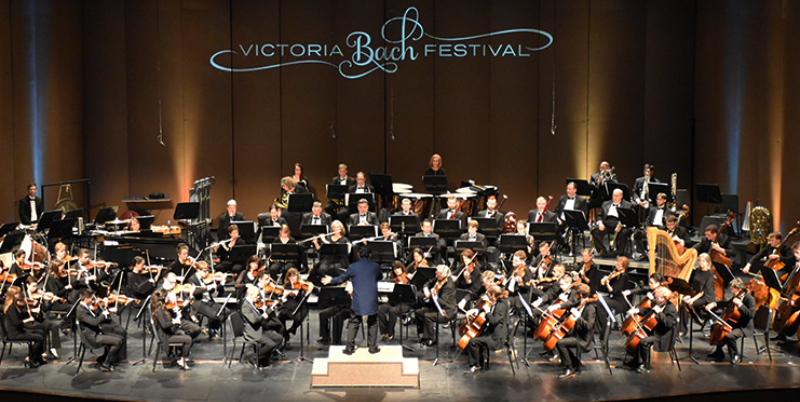A HEROIC JOURNEY
Saturday, June 10, 2023 | 7:30 PM
Victoria Fine Arts Center
1002 Sam Houston Drive
JOAN TOWER (b. 1938)
Fanfare for the Uncommon Woman
AARON COPLAND (1900 – 1990)
Fanfare for the Common Man
LUDWIG VAN BEETHOVEN (1770 – 1827)
Coriolan Overture
JOHN WILLIAMS (b. 1932)
Superman (Main Title)
INTERMISSION
GUSTAV MAHLER (1860 – 1911)
Symphony No. 1 in D major, “Titan”
- Langsam. Schleppend (Slowly. Dragging.)
- Kräftig bewegt, doch nicht zu schnell. (Moving vigorously, but not too fast.)
- Feierlich und gemessen, ohne zu schleppen. (Solemn and measured, without dragging.)
- Stürmisch bewegt. (With stormy emotion.)
Victoria Bach Festival Orchestra
Alejandro Hernandez-Valdez, conductor
VBF Orchestra
VIOLIN I
Nicholas Tavani, concertmaster
Jackson Guillen
Jennifer Dalmas
Abigail Bellorin
Karen Stiles
Elise Winters
Joseph Smith
Joan Carlson
Gesa Kordes
Maria Lin
Bruce Colson
Caleb Polashek
VIOLIN II
Corinne Stillwell, principal
Juan Jaramillo
Susan Doering
James Anderson
Christabel Lin
Helen Pat Karakas
Turner Partain
Boel Gidholm
Melissa Balli
Nina Mavrinac
Katie McCoy
VIOLA
Caitlyn Lynch, principal
Luis Bellorin
Melissa Brewer
Jann Cosart
Brett Detweiler
Désirée Elsevier
Korine Fujiwara
Lana Harris
Vincent Marks
CELLO
Christopher Haritatos, principal
Matt Armbruster
Justin Balli
Barbara George
Eric Mun
Shawn Sanders
Dieter Wulfhorst
DOUBLE BASS
Andrew Potter, principal
Patrick de los Santos
Chris Flores
Melanie Punter
Jonathan Rouse
FLUTE
Rachel Woolf, principal
Hilary Janysek
Izumi Miyahara
Diana Sipes
OBOE
Ian Davidson, principal
Michael Johnson
Korrigan Korthauer
Mika Valenzuela
CLARINET
Vanguel Tangarov, principal
Molly Mayfield
Hilary Scop
Ivan Valbuena
BASSOON
Daniel Chrisman, principal
Bryan Chin-foon
Katia Osorio
FRENCH HORN
Peter Rubins, principal
Ann Marie Cherry
Patrick Hughes
Brett Kroenig
Lauren Piccione
Jill Rodriguez
Roger Simmons
TRUMPET
Chris Carrillo, principal
Lauren Eberhart
Ron Ledbetter
Mary Thorton
TROMBONE
Javier Stuppard, principal
Owen Homayoun
Martin McCain
TUBA
Raúl I. Rodríguez, principal
TIMPANI
Sherry Rubins, principal
Riely Francis
PERCUSSION
Thomas Burritt, principal
Thad Anderson
Graeme Francis
Nick Stange
HARP
Elaine Barber, principal

Sponsors
Janey & Melvin Lack

This concert is generously supported by our concert sponsors and by donors to the Victoria Bach Festival’s Annual Fund. Many thanks to our generous supporters!
The works on this program celebrate heroism, as envisioned by five iconic composers. Aaron Copland, long seen as the archetypal American composer, was inspired by a speech given in 1942 by Henry Wallace, Franklin D. Roosevelt’s vice president. This speech, by a farmer who had served as Secretary of Agriculture, honored the coming era of the “common man.”
Scored for brass and percussion (timpani, gong, bass drum), many see this fanfare as a true depiction of the American ethos: bold, brassy, and strong with the wide intervals tracing vast open spaces. Few, though, recognize the challenge this piece poses with instruments often at the extremes of their ranges playing in octaves or the pure intervals of fourths and fifths, where the slightest error would blare like a siren.
A generation later in 1986, the Houston Symphony commissioned the first of six fanfares “for the uncommon woman” by American composer Joan Tower. In her individual voice, Tower boldly goes where no American woman had gone before, using Copland’s “male” ensemble of brass and percussion to celebrate heroic “women who take risks and are adventurous.” But she adds melodic percussion (glockenspiel, marimba, chimes) and swirling figures in the trumpets, perhaps portraying Ginger Rogers in a ball gown doing everything Fred Astaire did, but “backwards and in high heels.” Bear in mind that in the Eighties, Paula Hawkins heroically ran and became the first woman elected to the US Senate on her own merit (not replacing a husband or father) and El Paso-born Sandra Day O’Connor became the first woman to be confirmed to the US Supreme Court. True heroes.
Nearly two centuries earlier, Ludwig van Beethoven had suffered disappointment in a hero. Having dubbed his third symphony “Eroica [Heroic],” dedicated to Napoleon Bonaparte, a leader he thought would usher in a glorious French republic, he erased Napoleon’s name from the 1804 dedication when Bonaparte crowned “emperor.” Beethoven composed an overture for a play by Heinrich von Collin, telling the tragic story of Coriolanus, a general who betrays both enemies and friends. The true hero of this story is the general’s mother (represented in the second theme) who convinces him not to continue his betrayal. In the tradition of German romanticism, the deeply troubled Coriolanus repents and commits suicide. Beethoven’s setting is both strong and sensitive, determined and delicate.
Similarly with power and pathos, John William‘s overture to the 1978 film Superman, tells the story of Kal-El, an immigrant from a foreign land, determined to be of service to truth, justice, and the American way. Using his strengths, while conquering his weaknesses, Superman became a symbol of hope during America’s Great Depression.
A century before Willams’ mythical hero, Gustav Mahler began composing his first symphony. For a decade after it was first performed in 1889 as a two-movement symphonic poem, he edited and revised, named and renamed until 1899 when it reached its final form as a four-movement symphony. Titan, a novel by Jean Paul, inspired the symphony’s initial program, telling the story of a passionate youth whose bravery leads him to lead his nation.
Those who attended the VBF lieder program will not be surprised, then, that Mahler used excerpts from Lieder eines fahrenden Gesellen [Songs of a Traveling Freelancer], songs of a young man traveling bravely on his own, celebrating nature’s beauties, while mourning unrequited love. With offstage hunting horns and the oboe as the cuckoo, the first movement’s main theme comes from the second song in the cycle, Ging heut morgen übers Feld [I walked across the fields this morning]. Mahler sets the second movement, traditionally a minuet or scherzo, as a ländler, a sturdy Austrian folk dance.
The third movement dirge is based on a woodcut for children by Austrian Moritz von Schwind (often attributed to Jacques Callot). It illustrates hares, deer, foxes, and owls of the forest who escort a hunter’s funeral carriage. Cats in the forefront play instruments. The main theme is the children’s tune Frère Jacques, known in German as Bruder Jakob, a tune Mahler intended to be “eerie and ironical, brooding and sultry.”
The final movement, ending both this symphony and this concert portrays an epic scene as the valiant hero battles against the forces of hell (F minor) in order to reach victory in heaven (D major). This is an energisch [energetic] ending for an energetic program honoring heroes both distant in time and among us in the here and now.
–Dr. Yvonne Kendall, © 2023
Heroic Journey
The works on this program celebrate heroism, as envisioned by five iconic composers. Aaron Copland, long seen as the archetypal American composer, was inspired by a speech given in 1942 by Henry Wallace, Franklin D. Roosevelt’s vice president. This speech, by a farmer who had served as Secretary of Agriculture, honored the coming era of the “common man.”
Scored for brass and percussion (timpani, gong, bass drum), many see this fanfare as a true depiction of the American ethos: bold, brassy, and strong with the wide intervals tracing vast open spaces. Few, though, recognize the challenge this piece poses with instruments often at the extremes of their ranges playing in octaves or the pure intervals of fourths and fifths, where the slightest error would blare like a siren.
A generation later in 1986, the Houston Symphony commissioned the first of six fanfares “for the uncommon woman” by American composer Joan Tower. In her individual voice, Tower boldly goes where no American woman had gone before, using Copland’s “male” ensemble of brass and percussion to celebrate heroic “women who take risks and are adventurous.” But she adds melodic percussion (glockenspiel, marimba, chimes) and swirling figures in the trumpets, perhaps portraying Ginger Rogers in a ball gown doing everything Fred Astaire did, but “backwards and in high heels.” Bear in mind that in the Eighties, Paula Hawkins heroically ran and became the first woman elected to the US Senate on her own merit (not replacing a husband or father) and El Paso-born Sandra Day O’Connor became the first woman to be confirmed to the US Supreme Court. True heroes.
Nearly two centuries earlier, Ludwig van Beethoven had suffered disappointment in a hero. Having dubbed his third symphony “Eroica [Heroic],” dedicated to Napoleon Bonaparte, a leader he thought would usher in a glorious French republic, he erased Napoleon’s name from the 1804 dedication when Bonaparte crowned “emperor.” Beethoven composed an overture for a play by Heinrich von Collin, telling the tragic story of Coriolanus, a general who betrays both enemies and friends. The true hero of this story is the general’s mother (represented in the second theme) who convinces him not to continue his betrayal. In the tradition of German romanticism, the deeply troubled Coriolanus repents and commits suicide. Beethoven’s setting is both strong and sensitive, determined and delicate.
Similarly with power and pathos, John William‘s overture to the 1978 film Superman, tells the story of Kal-El, an immigrant from a foreign land, determined to be of service to truth, justice, and the American way. Using his strengths, while conquering his weaknesses, Superman became a symbol of hope during America’s Great Depression.
A century before Willams’ mythical hero, Gustav Mahler began composing his first symphony. For a decade after it was first performed in 1889 as a two-movement symphonic poem, he edited and revised, named and renamed until 1899 when it reached its final form as a four-movement symphony. Titan, a novel by Jean Paul, inspired the symphony’s initial program, telling the story of a passionate youth whose bravery leads him to lead his nation.
Those who attended the VBF lieder program will not be surprised, then, that Mahler used excerpts from Lieder eines fahrenden Gesellen [Songs of a Traveling Freelancer], songs of a young man traveling bravely on his own, celebrating nature’s beauties, while mourning unrequited love. With offstage hunting horns and the oboe as the cuckoo, the first movement’s main theme comes from the second song in the cycle, Ging heut morgen übers Feld [I walked across the fields this morning]. Mahler sets the second movement, traditionally a minuet or scherzo, as a ländler, a sturdy Austrian folk dance.
The third movement dirge is based on a woodcut for children by Austrian Moritz von Schwind (often attributed to Jacques Callot). It illustrates hares, deer, foxes, and owls of the forest who escort a hunter’s funeral carriage. Cats in the forefront play instruments. The main theme is the children’s tune Frère Jacques, known in German as Bruder Jakob, a tune Mahler intended to be “eerie and ironical, brooding and sultry.”
The final movement, ending both this symphony and this concert portrays an epic scene as the valiant hero battles against the forces of hell (F minor) in order to reach victory in heaven (D major). This is an energisch [energetic] ending for an energetic program honoring heroes both distant in time and among us in the here and now.
–Dr. Yvonne Kendall, © 2023
About the Artists

Alejandro Hernandez-Valdez, conductor
New York, New York
Esteemed conductor and pianist Dr. Alejandro Hernandez-Valdez was named Artistic Director of Musica Viva NY and Director of Music of the historic Unitarian Church of All Souls in Manhattan in 2015. He is also Co-Founder of the New Orchestra of Washington and Artistic Director of the Victoria Bach Festival. He has earned accolades from The Washington Post as a conductor “with the incisive clarity of someone born to the idiom,” as well as praise from The New York Times for leading “a stirring performance” of Brahms’ Ein Deutsches Requiem. His guest conducting engagements include appearances at The Kennedy Center in Washington, D.C., Lincoln Center in New York City, and the Degollado Theatre in Guadalajara, Mexico, where he led the Jalisco Philharmonic. As a pianist, Hernandez-Valdez performed for the 2013 Britten 100 festival in New York, organized by the Britten-Pears Foundation to honor the 100th anniversary of the titular composer’s birth. Read full bio
See our full 2023 artist list for additional biographical information.


